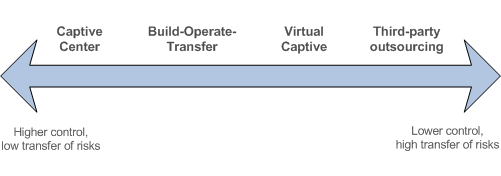

Nowadays businesses can choose from multiple offshore/nearshore delivery models such as third-party outsourcing (project-based or dedicated resources),
captive center, Build-Operate-Transfer (BOT) or joint venture.
In the recent years the concept of “virtual captives” has emerged and gained acceptance of the global sourcing community. It was originally introduced in the BPO segment, but looks promising for ITO and software development as well.
The choice of the appropriate delivery model is in most cases determined by the desired level of control and risks transfer. The following diagram illustrates how delivery models are ranged by these factors.

Adapted from: “Different Strokes for Different Folks: Outsourcing vs. Captives”
Enterprises using the traditional sourcing models (captive or third-party outsourcing) usually have to make trade-offs in terms of cost vs. control, dedicated vs. transient resources, outsource vs. retain non-core functions, generic vs. customized processes to name just a few. So they either retain all functions in-house through captive center or outsource to a vendor.
Virtual captive model (also known as hybrid or synthetic captive) is supposed to mitigate these discrepancies by garnering the benefits of traditional models. Basically it represents a captive center which is run by a third-party vendor in accordance with operational agreement. Supplier provides not only dedicated resources, leased facilities, infrastructure and assets, but also related services like recruitment, training, management of facilities/infrastructure and finances.
Thus third party is responsible for almost all day-to-day operations. This results in a captive-like environment where customer has control over processes and technology. Buyer can also control or have input to hiring and training as well as interview key resources. Improved control is facilitated by regular direct reporting by the virtual captive’s management to the client.
Customer plays crucial role in integrating the dedicated team of the virtual captive into their organizational culture. This is usually done through regular visits, reviews, appraisals, training on values, co-branded office facilities, rotation of onsite assignments etc. In its turn on the operational level vendor makes necessary process customizations, continuously improves processes and aligns objectives in accordance with client’s corporate strategy/vision. Customer is given the visibility and control of the outsourced process. Important decisions are made jointly under agreed-upon governance structure.
Business Case
Virtual captive seems to be the best fit when neither pure captive nor third-party outsourcing can fully satisfy customer’s specific requirements. It is typically a model of choice for:
Benefits
Besides cost reduction, virtual captives are driven by the following set of distinct benefits:
One may argue that many of the listed benefits can be attained by using Build-Operate-Transfer model. The main difference between BOT and virtual captive is absence of transfer phase after the specified period of time. Virtual captive is rather a long-term Build-Operate process. There is no need for the customer to establish a legal entity and bank accounts in the foreign country.
Virtual captive also allows to avoid effort-consuming transfer price negotiations that have place in BOT model. The client does not own the center but enjoys benefits of both traditional models (captive and third-party) and has higher control over the operations. Virtual captives provide great flexibility in terms of costs, resources and returns. They serve as an extended and culturally integrated part of the client’s organization.
Challenges
Along with benefits the virtual captive model also has several challenges that need to be taken into consideration in the process of choosing the most appropriate delivery model for your business.
While initial costs associated with virtual captive engagement may be greater than in case of third-party outsourcing, this delivery model proves to be more cost effective than running company-owned captive center. This is because fixed costs which the customer would incur in pure captive model are turned into variable in the virtual captive option.
There is evidence that world renowned business (i.e. General Electric, Nissan, Wachovia), having spent years experimenting with different delivery models, made their choice in favor of virtual captives. This testifies to the fact that it often makes more sense to partner with local vendor for setting up the offshore/nearshore delivery rather then adopt do-it-yourself approach.
After all, the best solution is the one that fits customer’s particular needs and environment its organization operates in.

